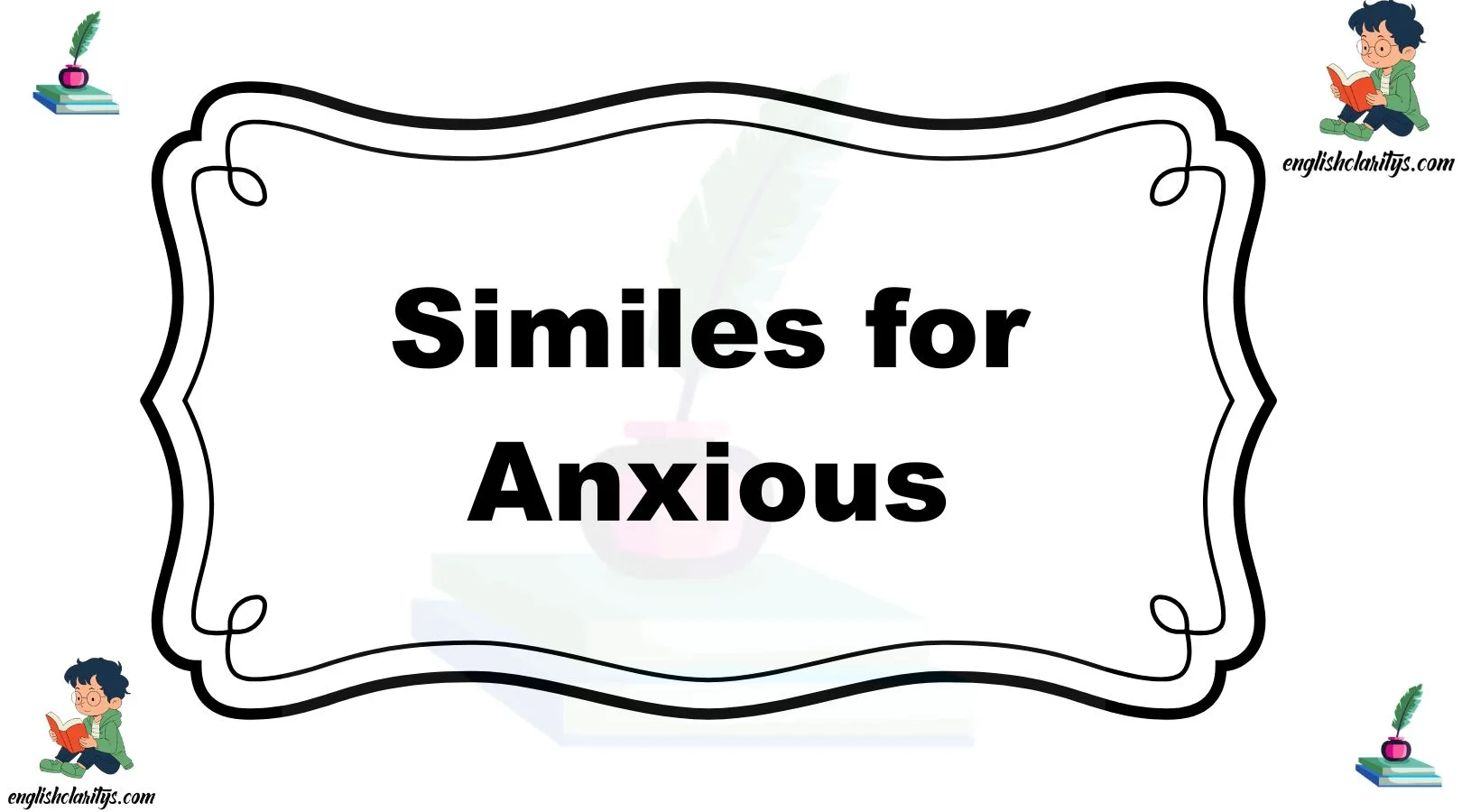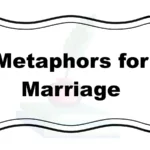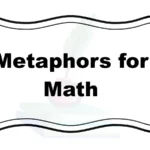In moments of anxiety, finding the right words can feel as important as finding solid ground under your feet. Using vivid comparisons helps you convey nervous energy, racing thoughts, or fluttering nerves in a way that others can truly understand. Similes for anxious feelings transform intangible stress into relatable images—whether it’s “as jittery as a sparrow’s wings” or “as taut as a drawn bowstring.”
These carefully chosen phrases bring warmth and empathy to your communication, making your message feel more personal, more vivid, and more comforting. Read on for 25 original similes that capture every shade of anxiety, complete with examples and guidance for using them with care.
What Does “Similes for Anxious” Mean?
Similes for anxiety are expressive comparisons using “like” or “as” to describe the physical sensations and emotional turmoil of anxiety. Instead of merely stating “I’m anxious,” these similes paint a vivid picture—linking racing hearts, restless minds, and trembling hands to familiar images. They help your readers or listeners feel what you’re experiencing, fostering connection and understanding.
When to Use “Similes for Anxious”
Use similes for anxiety whenever you want to communicate nervousness, worry, or tension in a way that resonates. Whether you’re writing a personal journal, crafting dialogue for a character, or sending an encouraging note to a friend, these comparisons make your description more relatable and more human. They’re perfect for blog posts about mental health, support messages, or any context where you wish to express anxiety with warmth and clarity.
Pros and Cons for “Similes for Anxious”
Pros:
- Adds emotional depth by making anxiety tangible
- Enhances empathy—readers grasp your feelings easily
- Enriches storytelling with vivid, sensory language
- Provides variety—avoids repetitive “nervous” or “worried”
- Connects with mental–health audiences through relatable imagery
Cons:
- Overuse may feel dramatic in casual contexts
- Some metaphors can confuse if too obscure
- May distract from factual information in formal writing
- Risk of cliché if common similes are reused
- Could trigger discomfort in highly sensitive readers
1. As jittery as a sparrow’s wings
Definition: Compares anxious trembling to a bird’s rapid wing beats.
Detailed Explanation: A sparrow’s wings flutter rapidly when startled or nervous, mirroring human jitters under stress.
Scenario Example: She paced the hallway as jittery as a sparrow’s wings.
Best Use: Describing visible, shaky nerves.
Worst Use: Not for internal, silent worry.
Tone: Agitated, vivid, relatable
3 Other Ways to Say It:
- As twitchy as a startled mouse
- Shaky like a leaf in the wind
- Quivering as a candle flame in a breeze
2. As taut as a drawn bowstring
Definition: Compares tension to a bowstring pulled tight.
Detailed Explanation: A pulled bowstring hums with potential energy—like a mind brimming with anxious thoughts.
Scenario Example: His nerves felt as taut as a drawn bowstring before the speech.
Best Use: Expressing high mental tension.
Worst Use: Unsuitable for low-level worry.
Tone: Intense, sharp, dramatic
3 Other Ways to Say It:
- Tight like a coiled spring
- Strained as an overfilled suitcase
- Stretched like a rubber band
3. As fluttery as a butterfly’s dance
Definition: Mirrors light, erratic movement to anxious butterflies in the stomach.
Detailed Explanation: Butterflies flit unpredictably—paralleling stomach flutters when you’re anxious.
Scenario Example: She felt as fluttery as a butterfly’s dance waiting for the call.
Best Use: Describing stomach nerves.
Worst Use: Not for outward panic.
Tone: Light, poetic, intimate
3 Other Ways to Say It:
- Fluttering like a hummingbird’s wings
- Skittering like autumn leaves
- Quivering as a hummingbird
4. As twitchy as a broken faucet
Definition: Compares repetitive spasms to a faucet that won’t stop dripping.
Detailed Explanation: A leaking faucet’s steady drip mirrors involuntary physical anxiety tics.
Scenario Example: His leg bounced as twitchy as a broken faucet during the meeting.
Best Use: Depicting nervous habits.
Worst Use: Poor fit for silent anxiety.
Tone: Humorous, concrete, relatable
3 Other Ways to Say It:
- Jerky like a skipping record
- Flickering like a faulty light
- Spasming as a hiccup
5. As uneasy as a cat in a room full of rocking chairs
Definition: Illustrates constant alertness and worry.
Detailed Explanation: A cat surrounded by rocking chairs must stay vigilant—like someone anxious about every possible danger.
Scenario Example: He sat as uneasy as a cat in a room full of rocking chairs on exam day.
Best Use: Capturing hypervigilance.
Worst Use: Not apt for calm anxiety.
Tone: Playful, vivid, tense
3 Other Ways to Say It:
- Guarded like a soldier under fire
- Alert as a deer in headlights
- On edge like a tightrope walker
6. As restless as a stormy sea
Definition: Compares turbulent waves to an unsettled mind.
Detailed Explanation: A stormy sea never settles—much like racing thoughts that churn with anxiety.
Scenario Example: Her mind was as restless as a stormy sea before the audition.
Best Use: Portraying mental turmoil.
Worst Use: Unsuitable for mild worry.
Tone: Dramatic, turbulent, intense
3 Other Ways to Say It:
- Churning like boiling water
- Roiling as molten lava
- Surging like tidal waves
7. As prickly as a hedgehog
Definition: Equates anxiety to protective, stiff spines.
Detailed Explanation: Hedgehogs curl into spikes when threatened—like someone bristling with nervousness.
Scenario Example: He answered questions as prickly as a hedgehog in unfamiliar territory.
Best Use: Highlighting defensive anxiety.
Worst Use: Not for open, calm concern.
Tone: Defensive, sharp, vivid
3 Other Ways to Say It:
- Bristling like a porcupine
- Thorny as a rose bush
- Spiky like cactus
8. As shaky as jelly on a plate
Definition: Compares unstable nerves to wobbly gelatin.
Detailed Explanation: Jelly trembles at the slightest touch—just like knees or hands under stress.
Scenario Example: Her hands were as shaky as jelly on a plate typing the email.
Best Use: Depicting physical trembling.
Worst Use: Poor fit for mental unease.
Tone: Light, tactile, clear
3 Other Ways to Say It:
- Wobbly like a suspended bridge
- Jiggly like a loose sign
- Quaking as a quake
9. As tight as a drum
Definition: Compares taut nerves to a drumhead stretched for a beat.
Detailed Explanation: A drumhead pulled tight vibrates with tension—mirroring anxious anticipation.
Scenario Example: His chest felt as tight as a drum before the verdict.
Best Use: Expressing chest constriction.
Worst Use: Not for relaxed nerves.
Tone: Rhythmic, tense, vivid
3 Other Ways to Say It:
- Strung like guitar strings
- Stretched like a canvas
- Taut as a trampoline
10. As frantic as bees in a hive
Definition: Equates buzzing activity to chaotic thoughts.
Detailed Explanation: Bees swarm unpredictably—like a mind overloaded with anxious ideas.
Scenario Example: Her thoughts buzzed as frantic as bees in a hive during the presentation.
Best Use: Describing racing thoughts.
Worst Use: Not for quiet worry.
Tone: Busy, chaotic, vivid
3 Other Ways to Say It:
- Swarming like startled birds
- Whirring like a broken fan
- Chattering like monkeys
11. As prickly as static electricity
Definition: Likens anxious anticipation to a sudden electric shock.
Detailed Explanation: Static jolts can make you tense—similar to unexpected anxiety spikes.
Scenario Example: He felt as prickly as static electricity before the call.
Best Use: Capturing sudden nervous jumps.
Worst Use: Unsuitable for sustained worry.
Tone: Sharp, sudden, electrifying
3 Other Ways to Say It:
- Sparking like an outlet
- Tingling as a foot asleep
- Zapping like a taser
12. As jittery as popcorn in a pan
Definition: Mirrors the quick, erratic popping of kernels.
Detailed Explanation: Popcorn kernels jump unpredictably—like someone’s nerves under pressure.
Scenario Example: She sat as jittery as popcorn in a pan waiting for her name.
Best Use: Highlighting extreme restlessness.
Worst Use: Avoid for calm anxiety.
Tone: Energetic, restless, playful
3 Other Ways to Say It:
- Skipping like a stone
- Leaping like sparks
- Bouncing like rubber balls
13. As tense as a coiled snake
Definition: Associates latent threat with tightly wound nerves.
Detailed Explanation: A coiled snake holds energy ready to strike—like anxiety ready to erupt.
Scenario Example: He stood as tense as a coiled snake before the negotiation.
Best Use: Conveying imminent panic.
Worst Use: Not for mild unease.
Tone: Threatening, charged, vivid
3 Other Ways to Say It:
- Coiled like a spring
- Loaded as a gun
- Ready like a sprinter
14. As uneasy as a leaf in the wind
Definition: Compares fragile uncertainty to a leaf’s unpredictable drift.
Detailed Explanation: A leaf tumbles with every breeze—mirroring wavering nerves.
Scenario Example: She felt as uneasy as a leaf in the wind before the interview.
Best Use: Describing wavering confidence.
Worst Use: Unsuitable for resolute anxiety.
Tone: Gentle, uncertain, poetic
3 Other Ways to Say It:
- Fluttering like a torn page
- Drifting like smoke
- Swaying like a tether
15. As nervous as a long-tailed cat in a room full of rocking chairs
Definition: Evokes acute worry about every potential hazard.
Detailed Explanation: A cat with a long tail must dodge every chair—like someone fearing every possible outcome.
Scenario Example: He moved as nervous as a long-tailed cat in a room full of rocking chairs when he heard the news.
Best Use: For extreme hypervigilance.
Worst Use: Too strong for mild jitters.
Tone: Colorful, intense, vivid
3 Other Ways to Say It:
- Alert like a sentry on patrol
- Skittish as a startled fawn
- On edge like a minefield
16. As shaky as a tightrope walker’s hands
Definition: Highlights visible trembling under pressure.
Detailed Explanation: Tightrope walkers need steady hands; anxiety makes them shake—like someone terrified of falling.
Scenario Example: His grip was as shaky as a tightrope walker’s hands signing the contract.
Best Use: Showing fear of failure.
Worst Use: Not for controlled nerves.
Tone: Dramatic, visual, tense
3 Other Ways to Say It:
- Quivering like a new violin string
- Wavering as a candle in wind
- Trembling like first snowfall
17. As anxious as a mouse in a lion’s den
Definition: Conveys extreme fear in a threatening environment.
Detailed Explanation: A mouse among lions is terrified—like someone out of their depth.
Scenario Example: She felt as anxious as a mouse in a lion’s den starting her new job.
Best Use: Depicting intense intimidation.
Worst Use: Overkill for mild discomfort.
Tone: Fearful, vivid, dramatic
3 Other Ways to Say It:
- Petrified like a rabbit near a fox
- Terrified like prey in spotlight
- Frozen like a deer in headlights
18. As edgy as a broken record
Definition: Reflects repetitive, irritating loops of worry.
Detailed Explanation: A skipping record repeats—like anxious thoughts circling endlessly.
Scenario Example: His mind played back doubts as edgy as a broken record.
Best Use: Illustrating obsessive worry.
Worst Use: Not for one-off concerns.
Tone: Irritated, cyclical, vivid
3 Other Ways to Say It:
- Looping like a stuck CD
- Spinning like a hamster wheel
- Recycling like a stuck tape
19. As wound up as a grandfather clock
Definition: Compares pent-up anxiety to a clock’s spring mechanism.
Detailed Explanation: Wound clocks store energy that must release—like bottled-up tension.
Scenario Example: She felt as wound up as a grandfather clock before the deadline.
Best Use: For building pressure over time.
Worst Use: Not for sudden panic.
Tone: Steady, tense, anticipatory
3 Other Ways to Say It:
- Tight as a watch spring
- Coiled like a jack-in-the-box
- Ready as a mousetrap
20. As fluttering as autumn leaves in a gust
Definition: Mirrors uncontrolled flutters of worry.
Detailed Explanation: Leaves swirl unpredictably—like scattered anxious thoughts.
Scenario Example: His heart felt as fluttering as autumn leaves in a gust during the exam.
Best Use: Describing scattered attention.
Worst Use: Not for focused anxiety.
Tone: Poetic, restless, vivid
3 Other Ways to Say It:
- Dancing like confetti in wind
- Skittering like sparklers
- Whirling like dervish
21. As taut as a violin string
Definition: Emphasizes fine, delicate tension ready to snap.
Detailed Explanation: A violin string tuned high holds intense tension, much like frayed nerves.
Scenario Example: Her patience was as taut as a violin string after hours of waiting.
Best Use: For emotional fragility.
Worst Use: Not for robust calm.
Tone: Fragile, poised, musical
3 Other Ways to Say It:
- Strung like harp chords
- Tension like tight web
- Bound like stretched rubber
22. As restless as a caged tiger
Definition: Conveys fierce, pacing impatience.
Detailed Explanation: A tiger in confinement paces restlessly—like someone desperate to act.
Scenario Example: He waited as restless as a caged tiger for the test results.
Best Use: Capturing urgent nervous energy.
Worst Use: Too strong for mild worry.
Tone: Fierce, urgent, vivid
3 Other Ways to Say It:
- Pacing like a lion in a cage
- Fidgeting like a caged bird
- Straining like springs
23. As on edge as a razor blade
Definition: Conveys sharp, precarious tension.
Detailed Explanation: A razor’s edge is dangerously thin—mirroring acute anxiety.
Scenario Example: She felt as on edge as a razor blade before her performance.
Best Use: High-stakes situations.
Worst Use: Overkill for casual concern.
Tone: Sharp, intense, precarious
3 Other Ways to Say It:
- Keen like a honed knife
- Fine as spun glass
- Acute as a dagger
24. As breathless as someone running uphill
Definition: Equates physical breathlessness with anxious exertion.
Detailed Explanation: Climbing uphill leaves you gasping—like panic stealing your breath.
Scenario Example: He spoke as breathless as someone running uphill when telling his story.
Best Use: For panic-induced breathlessness.
Worst Use: Not for calm anxiety.
Tone: Gasping, urgent, vivid
3 Other Ways to Say It:
- Gasping like drowning
- Panting as a sprinter
- Wheezing like asthma attack
25. As shaky as a leaf during an earthquake
Definition: Compares small tremors to overwhelming anxiety.
Detailed Explanation: Leaves tremble uncontrollably in tremors—like being shaken by fear.
Scenario Example: Her voice was as shaky as a leaf during an earthquake on stage.
Best Use: Depicting extreme vulnerability.
Worst Use: Not for mild nerves.
Tone: Vulnerable, intense, vivid
3 Other Ways to Say It:
- Quivering like a baby’s lip
- Trembling like jelly
- Shivering as cold wind
Conclusion:
Similes for anxiety let you share the complexity of worry in images that resonate. Whether you choose “as fluttery as a butterfly’s dance” or “as tense as a coiled snake,” each comparison brings clarity, warmth, and empathy to your words. These similes help readers feel your nervous energy—and, in turn, connect more deeply. Use them thoughtfully to enrich your writing with vivid emotion and human understanding.
MCQs:
1. “As jittery as a sparrow’s wings” describes a person who is:
A) Calm and steady
B) Trembling with nervous energy
C) Bored and indifferent
D) Angry and loud
Answer: B
2. Which simile best conveys high mental tension?
A) As calm as a still lake
B) As taut as a drawn bowstring
C) As cozy as a blanket
D) As bright as sunshine
Answer: B
3. “As restless as a stormy sea” illustrates:
A) Peaceful serenity
B) Turbulent, racing thoughts
C) Deep sleep
D) Playful energy
Answer: B
4. What does “as uneasy as a cat in a room full of rocking chairs” imply?
A) Comfort and ease
B) Hypervigilance and worry
C) Laziness
D) Happiness
Answer: B
5. “As fluttery as a butterfly’s dance” focuses on:
A) Sudden fear
B) Tingling stomach nerves
C) Physical trembling of hands
D) Loud noises
Answer: B
6. Which simile shows defensive anxiety?
A) As prickly as a hedgehog
B) As gentle as a dove
C) As still as a statue
D) As bright as a star
Answer: A
7. “As shaky as jelly on a plate” is best for describing:
A) Erratic thoughts
B) Physical trembling
C) Emotional calm
D) Mental clarity
Answer: B
8. Which simile conveys frantic busyness?
A) As calm as a deep breath
B) As frantic as bees in a hive
C) As steady as sunrise
D) As soft as a pillow
Answer: B
9. “As prickly as static electricity” suggests:
A) Smooth comfort
B) Sudden nerve jolts
C) Gentle rest
D) Warmth
Answer: B
10. Which simile depicts obsessive worry?
A) As edgy as a broken record
B) As gentle as morning dew
C) As quiet as snowfall
D) As peaceful as sunset
Answer: A
11. “As wound up as a grandfather clock” refers to:
A) Slow relaxation
B) Bottled-up tension ready to release
C) Calm reflection
D) Light playfulness
Answer: B
12. What does “as poised as a tightrope walker’s hands” illustrate?
A) Steady composure under pressure
B) Extreme panic
C) Bored confidence
D) Loud agitation
Answer: A
13. “As anxious as a mouse in a lion’s den” conveys:
A) Comfortable setting
B) Intense intimidation
C) Playful curiosity
D) Deep sleep
Answer: B
14. Which simile fits scattered attention?
A) As fluttering as autumn leaves in a gust
B) As focused as a laser beam
C) As calm as dusk
D) As steady as a rock
Answer: A
15. “As shaky as a leaf during an earthquake” describes:
A) Mild nerves
B) Extreme vulnerability
C) Calm acceptance
D) Bright optimism
Answer: B
FAQs:
1. What are similes for anxiety, and why should I use them?
Similes for anxiety are comparisons using “like” or “as” that vividly describe feelings of worry, tension, or nervous energy. They help you transform internal experiences—racing thoughts, trembling hands, fluttery stomachs—into images readers can easily visualize and empathize with. Using these similes makes your writing more engaging, relatable, and emotive, so others truly feel the weight of your anxiety.
2. Can I use these similes in professional or academic writing?
Yes—with care. In creative reports, personal reflections, or presentations on mental health, these similes can bring a human touch. In strictly formal or technical documents, use them sparingly and only when you want to convey emotional nuance. Always ensure the tone matches your audience’s expectations and the document’s purpose.
3. How many similes should I include in one piece of writing?
Aim for one to three strong similes in a short passage or paragraph. Overloading your text can dilute their impact and make the writing feel ornamental. Place them where you want to draw attention to a moment of high tension or vulnerability, then rely on clear, direct language elsewhere to maintain balance.
4. What’s the difference between a simile and a metaphor when describing anxiety?
A simile uses “like” or “as” to make a comparison (e.g., “as twitchy as a broken faucet”), while a metaphor states one thing is another (e.g., “my nerves were a frayed rope”). Similes tend to feel gentler and more explicit, which can be helpful for sensitive topics like anxiety. Choose whichever device best fits your tone and clarity needs.
5. Can I create my own similes for anxiety based on personal experience?
Absolutely! The most powerful similes often come from personal observations. Think of an image or sensation that matches your own experience of anxiety—whether it’s the buzz of a fluorescent light or the tension in a violin string—and frame it with “like” or “as.” Original comparisons make your writing uniquely authentic and memorable.




